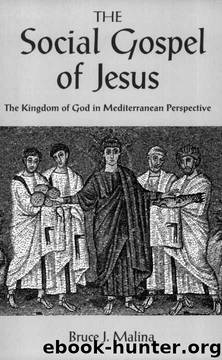The Social Gospel of Jesus by Malina Bruce J

Author:Malina, Bruce, J [Malina, Bruce, J]
Language: eng
Format: epub, mobi
Published: 2007-08-28T00:00:00+00:00
4. Face-to-Space Modes of Social Interaction
Disembodied-extended integration maintains the integration of persons by means of networks of connections where modalities of face-to-face interaction, clientelism, and the continuing practices of intermediate agents are not salient features of political control and social relation. In disembodied-extended political social interaction, humans as bodily beings are discounted by technologies of communication and exchange across time and space, the "information society." This mode of social interaction emerges only with the nation-state.
The nation-state has its roots in the dawning humanism of the Renaissance period. At that time a number of persons sensed that the events of classical history and legend as well as those of the Bible were not separated from the present simply by a span of time. Instead, completely different conditions of life existed in the past. The subsequent discovery of new lands made it possible for Europeans to think of Europe as only one among many civilizations, not necessarily the chosen or the best. Finally, out of multiple experiences and experiments in the Americas, Europeans learned to think in terms of the following imagined realities: nation-states, republican institutions, common citizenships, popular sovereignty, national flags and anthems, and so on. Thinking in terms of these categories entailed the liquidation of their conceptual opposites: dynastic empires, monarchical institutions, absolutisms, subjecthoods, inherited nobilities, serfdoms, walled ghettoes, and so forth.
Furthermore, the validity and generalizability of the American experience (South America as well as North America) as blueprint were undoubtedly confirmed by the plurality of the independent states that soon arose. In effect, by the second decade of the nineteenth century, if not earlier, a model of the independent national state was available for adoption by human groups around the world (Anderson 1991: 37-65).
Media at this level do not rely on the prior face-to-face relationship of sender and audience (newspapers, television, radio, Internet). Yet they assume ontological continuity of the embodied office holder and the disembodied sets of images that make the office holder present to the governed. The nation-state thus consists of distant, privatized, and/or still localized strangers integrated by media as disembodied-extended linkage, providing new immediacy. We are there with a new nationalism at the Olympics, World Cup Finals, the Gulf War, and the United Statesinspired NATO war in the former Yugoslavia. People speak and act in the name of the nation while effectively acting to displace it.
The experience of change, that is, time, is made even more abstract. When it comes to tradition, features to be handed down have to be chosen by individuals rather than experienced as engulfing and supporting them. Tradition is now a self-consciously maintained, selected set of practices. And human bodily presence is rendered equally abstract. Physical co-presence has to be chosen by individuals, rather than engulfing and supporting them. Co-presence is a self-consciously maintained, selected set of persons with whom one might wish to interact, often passively (while watching television programs, listening to the news, speaking on the phone).
Finally, space too is now abstract. Space is not the land of one's birth and nurture, but rather a territory marked off and controlled by some central power.
Download
This site does not store any files on its server. We only index and link to content provided by other sites. Please contact the content providers to delete copyright contents if any and email us, we'll remove relevant links or contents immediately.
| Guides | New Testament |
| Old Testament |
The Five People You Meet in Heaven by Mitch Albom(2845)
Name Book, The: Over 10,000 Names--Their Meanings, Origins, and Spiritual Significance by Astoria Dorothy(2494)
Real Sex by Lauren F. Winner(2479)
The Holy Spirit by Billy Graham(2421)
The Secret Power of Speaking God's Word by Joyce Meyer(2255)
0041152001443424520 .pdf by Unknown(2225)
How The Mind Works by Steven Pinker(2216)
ESV Study Bible by Crossway(2121)
Ancient Worlds by Michael Scott(2107)
The Meaning of the Library by unknow(2071)
The Gnostic Gospels by Pagels Elaine(2029)
Churchill by Paul Johnson(2015)
MOSES THE EGYPTIAN by Jan Assmann(1974)
The ESV Study Bible by Crossway Bibles(1938)
Jesus by Paul Johnson(1892)
The Nativity by Geza Vermes(1851)
Ancient Near Eastern Thought and the Old Testament by John H. Walton(1850)
The Complete Dead Sea Scrolls in English (7th Edition) (Penguin Classics) by Geza Vermes(1844)
City of Stairs by Robert Jackson Bennett(1828)
